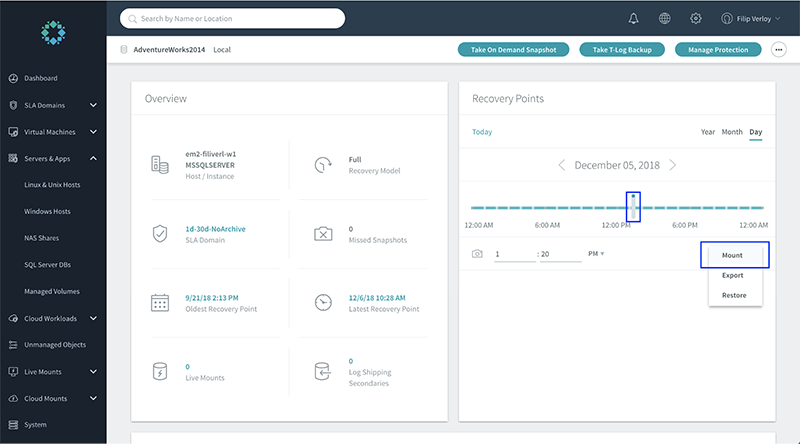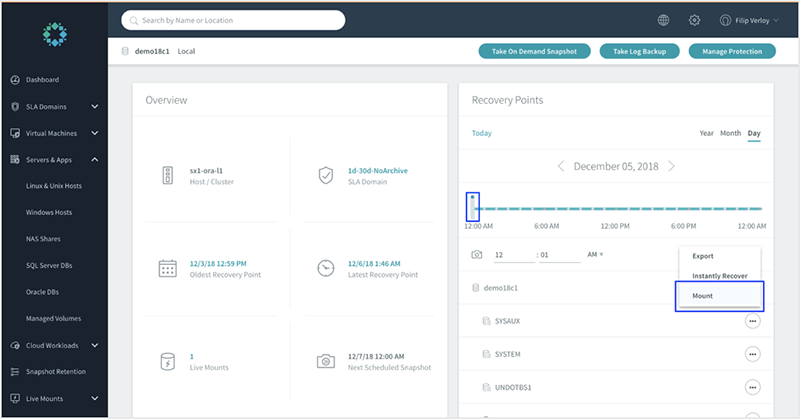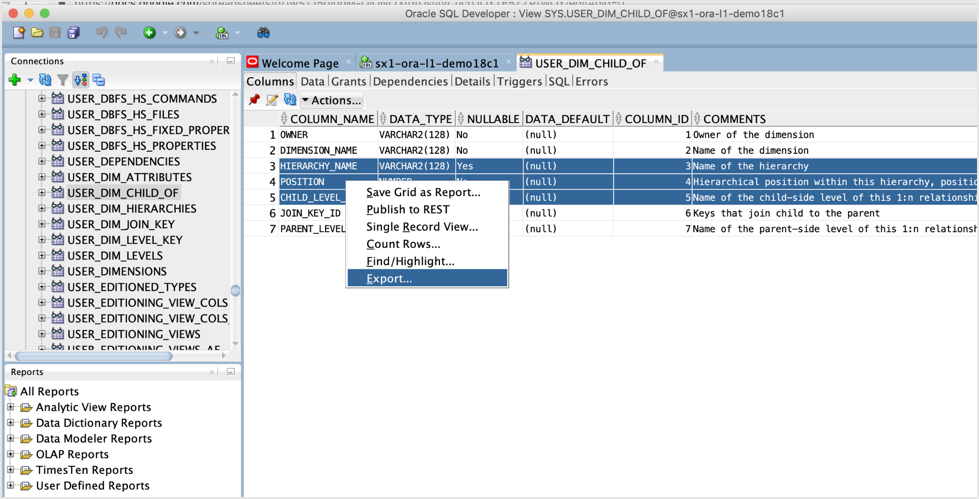As organizations continue to ramp up their efforts to collect and analyze more data, a variety of privacy and data protection regulations have been set to support users’ personal information. In many cases, organizations must now rework their data protection strategy to comply with these new laws while also leveraging the business value of data.
As a Cloud Data Management company, Rubrik wants to make it easier for our customers to deal with all aspects of protecting and managing their data, and facilitating compliance is a critical aspect of that. Backup and recovery can be an especially challenging part of privacy compliance. In this blog post, I’ll focus on selective restores in light of these regulations–though they’re very handy in any DBA’s toolbox.
Under the Hood
Recovery is an important aspect of many privacy and data protection requirements. Rubrik’s Live Mount feature makes queryable data recovery and selective restores for databases quick and easy. Rubrik initially built this capability for VMs and has expanded it over time to include workloads like traditional physical and virtual relational databases. At a high level, Live Mount makes use of the performance and storage capabilities of the Rubrik cluster to instantly mount the workload instead of needing to stream it back to the production system. Once the workload is mounted, you have a read/write copy of any historical backup that you can selectively restore back into production. This approach helps organizations avoid restoring data that must be deleted as a result of privacy laws.
To see the benefits of Live Mount in action, let’s dive into exactly how this works using some structured data sources as examples. Here are three examples of how Rubrik delivers queryable recovery for multiple environments.
Microsoft SQL Server
Some of Rubrik’s biggest innovations that support instant data availability have been around its SQL Server Live Mount capability, which quickly restores in just a few steps. Let’s take a closer look:
First, use our Google-like predictive search to quickly locate the desired database. Once the database is discovered, instead of selecting “Restore” to recover the entire dataset, choose the “Mount” feature to present a copy of the database to an MS SQL host of your choice.

You can select any compatible host and SQL instance (can be cross-version) to present this backup copy to by simply providing the database name (“SQLLM” in this example) and selecting “Mount.”

The selected historical copy is now running from the Rubrik cluster and is attached to the MS SQL environment of your choice.

Seeing that you now have access to both the production and backup data set, it is very easy to query for the data you need. Simply SELECT and INSERT the data of your choice back into production while leaving unwanted records behind.
Oracle Databases
You can also use Rubrik’s Live Mount capability to deliver instant recovery and clones for Oracle databases with this same level of simplicity. As with MS SQL, Live Mount for Oracle involves searching the database of interest and selecting the point-in-time to which you want to restore. Then, use the “Mount” feature to present a copy of the database to an Oracle host of your choice.

You can select any compatible standalone Oracle host or cluster (can be cross-version) to present this backup copy.

The selected historical copy is now running from Rubrik and is attached to the Oracle environment of your choice.

Additionally, you can use Rubrik for individual Oracle tablespace restores, further expanding your toolset arsenal to quickly address different recovery needs.

NoSQL Databases
Rubrik Datos IO delivers next-gen data management for the world’s most popular NoSQL databases such as Apache Cassandra, DataStax, and MongoDB. In our Rubrik Andes 5.0 release, we introduced the first integration between Rubrik and Rubrik Datos IO. Through Datos IO, you can selectively restore these NoSQL environments to provide greater control and more operational flexibility.
With our queryable restore capability for NoSQL environments, you can selectively restore specific data from your backup data (e.g. choosing specific records from a collection for MongoDB). Using queryable data recovery, you can create select criteria to query specific columns and rows from backups. The result is flexible sub-table level recovery and near-zero RTOs for NoSQL databases.
The query criteria can be selected through a streamlined GUI in Rubrik Datos IO. You can choose the columns to restore and define conditions that select specific rows to include in the restore. For those who want to automate queryable restore, the capability can also be accessed via the CLI and API.

Why Queryable Recovery?
Why not delete the data from the backup itself? At first, this might seem like a good approach, but for many organizations, their backup system should be immutable and considered their storage of last resort, which adds to the risk of modifying these datasets. Additionally, the inability to delete every relevant data source from historical backup sets probably means that your solution has become more fragmented. Luckily, Rubrik addresses this challenge through its unified, simple approach to recovery that helps companies ease their path to compliance.
To learn more about Rubrik’s Live Mount capability, read this blog post.
